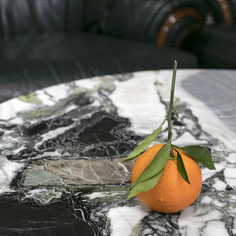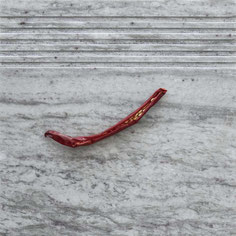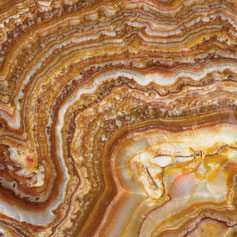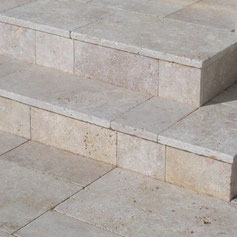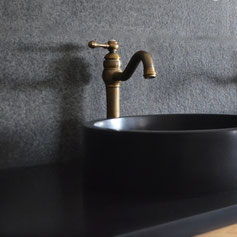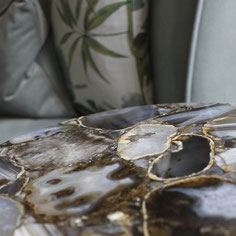natural stone
Whether you're designing your own kitchen or a luxurious business centre, you might think of adding to it natural stone elements. These can be a granite worktop, onyx reception desk, travertine floor, marble wall. The choice of natural stone colours and patterns is immense. There's a stone to match every interior and any space. Comparing the properties of different natural stones will help you decide which of them suits your project best.
The Magic of Natural stone
Each natural stone has its own distinct character, it's like a living personality in your home. Quiet, mysterious, mature - these are the words to describe any type of stone. However, these versatile stone qualities usually are complemented by some distinctive features that make one specimen stand out among the others. Have you noticed that marble has a reserved and classic look? In comparison to marble, onyx looks more sensitive and extravagant. Travertine looks modest at a glance and often tends to pass unnoticed, but at a closer look its surface reveals a pattern of playful small holes.
When brought to the earth's surface, natural rocks reveal their magic stories of millions of years old. Those sagas are engraved in their unique composition layers. The endless cycles of erosion and sedimentation, sinking and uplifting leave the trace in the face of stone, adorning it with veins and wrinkles. Have you thought that looking at your marble wall or gorgeous quartzite fireplace, you will be able to read those stories every day? As you slice bread on your granite countertop, you can watch its spellbinding journey unfold before your eyes.
There is a stone for every interior
The most common natural stone used by interior designers in their projects is marble. When looking at soft marble colours and subtle veining, it's easy to guess why. Light marble surfaces complement to interiors' air and elegance, while dark marble patterns add to conservative and classic looks.
Granite and quartzite stand out among other decorative stones in terms of their hardness and durability. Both granite and quartzite often surprise by bold colours and patterns. Pure quartzite rock is harder than granite. It is composed almost entirely of quartz particles. Pure quartzite rock is white, but due to accidentally trapped other minerals it can acquire fabulous colours and patterns. The charms of quartzite are hard to resist.
Because of its translucency and bold veins, the extravagant onyx makes itself highly outstanding in any interior. Onyx walls and partitions, when illuminated from the opposite side, create a real drama. Agate, aragonite and amethyst walls also glow when backlit, turning themselves into amazing pieces of natural art. Some non-translucent exotic stones, such as jasper, lazurite and amazonite, add to interiors' lavish and luxurious looks in other ways.
Have you thought that a sandstone countertop can teleport you to the desert while you sip coffee in your kitchen? Wavy yellow, orange, greyish sandstone patterns are closely reminiscent of dunes. Travertine looks modest and has a special earthy texture. Travertine's neutral look makes it fit almost anywhere. It is distinctive because of its tiny holes. These holes can either be left open or sealed with transparent sealants by worktop manufacturers.
Grey and black basalt looks reserved when compared to many other stones. It is less common in interiors though it has some outstanding characteristics. Environment-friendly, non-toxic and non-flammable basaltic rock naturally forms ocean floor. Basalt is ideal for outdoor use as it can withstand severe temperature fluctuations and extreme weather conditions. Strong and gallant basalt slabs are good heat retainers, their thermal insulation exceeds that of other stones.
natural stone fabricators
NATURAL STONE characteristics
| HEAT RESISTANT | WILL ETCH | WILL SCRATCH | WILL STAIN | CAN BACKLIGHT | HARDNESS MOHS | |
| GRANITE | X | 7 | ||||
| QUARTZITE | X | X | 7-7,5 | |||
| MARBLE | X | X | X | 3-4 | ||
| ONYX | X | X | X | X | 6-7 | |
| TRAVERTINE | X | X | X | 4-5 | ||
| SANDSTONE | X | X | X | 5,5-7 | ||
| BASALT | 7 | |||||
| PRECIOUS | X | X | X | X | 3-5 |
Where natural stones are found?
Different stones used in interior and exterior decoration are found as rocks in large solid chunks in the ground. They are transported from quarries in large blocks. Before being shipped, the blocks are cut into slabs of approx. 3.2 m long and 1.6 m wide, 2-4 cm thick. Natural stone slabs of incredible beauty arrive in Lithuanian stone fabricators warehouses from all over the world.
Natural conditions in different parts of the world lead to different minerals forming in the ground. This also explains the different composition, properties, textures and appearance of the same type of rocks found in different places. All these features in decorative stones can vary considerably.
White marbles mostly come from Italy. Some beautiful coloured marbles come from South America, Asia and Africa. Extravagant green and black granite slabs with veiny textures come from Brazil. The lands of ancient Egypt, Babylonia and Assyria were famous for exotic precious and semi-precious stones. Many gemstone slabs are still coming from the Middle East today.
the composition of stones
According to the famous Lithuanian geologist Vincentas Korkutis, it is only at first glance that rocks seem to be unchanging. Given the right conditions, they can change beyond recognition. Rocks are constantly forming and transforming under the ground. Nature's imagination has plenty of resources to run wild as there are more than 3,000 types of minerals beneath the earth.
Around 1/6 of the Earth's minerals (about 500) are found in larger quantities. They form the bases of the most common rocks. The rare ones are added to the base ones by nature as condiments to foods. The physical properties of stones used in interiors and construction mainly depend on the atomic size and valency of minerals they contain. Among the minerals in the Earth's crust, the most abundant are quartz, mica, feldspar, amphibole and pyroxenes. When quartz is broken down into the finest grains, it becomes sand.
Rocks can be simple and complex. Simple rocks consist of a single type of mineral. For example, marble and limestone are composed of calcite grains. Complex rocks consist of several types of minerals. Such complex type of rock is granite (Latin for 'granular'). The component parts of granite have different grains. Even without a magnifying glass it is easy to see irregular quartz grains, mica plates, brownish or grey feldspar crystals by observing granite surface.
The rocks found on the Earth's surface have been formed by physical and chemical processes. They are classified according to their origin as igneous, metamorphic and sedimentary. If your worktop is made of igneous rock, such as granite or basalt, it means that the earth spat this material out of its belly as liquid magma, or it was trapped on the way, cooling down before reaching the surface.
If your worktop is fabricated from a sedimentary rock, such a travertine, it means that it formed at the earth's surface from crystallised mineral deposits. If the origin of your stone countertop is metamorphic, it means that it has gone through a hell of heat and pressure in the earth's depths, transforming from one rock into another. Such metamorphic rock is marble.
How rocks are formed
Most rocks form in the depths of the earth and gradually rise to the surface through physical processes. The deeper the rocks sink, the higher the temperature and the higher the pressure. Lava erupting from the depth of 100 km reaches temperatures of 1200-1500 degrees Celsius. At these depths, rocks are subject to pressures of tens of thousands of atmospheres. Geologist Vincentas Korkutis, in his book "The World of Minerals", explains how these conditions produce minerals of astonishing beauty.
The Earth's depths are filled with magma, which is a viscous silicate mass made of silicon and oxygen and rich in dissolved chemical elements. Hot magma rises upwards under the influence of underground forces. If it solidifies before reaching the surface, intrusive rocks are formed. This means that hot silica compounds trapped in veins, cracks and fissures of earth penetrate through them into other rocks. Silicon compounds are abundant, they make up two-thirds of the Earth's crust. Silicon and aluminium compounds are present in feldspar, mica and other silicates. The composition of the newly formed rocks depends on the temperature and pressure at a given depth.
Magma erupting freely through fissures to the surface forms effusive rocks by rapid solidification. The elements in it don't have enough time to crystallise because the mass of magma solidifies too quickly. Effusive rocks include basalt, andesites and porphyrites, which are widely used as building materials. Such rocks form the Scandinavian mountains.
Closer to the surface, where the temperatures and pressure is lower, rocks start to weather and etch. Fine mineral deposits in rivers, seas and oceans build up sedimentary layers of sand, clay, chalk and other residue. Over thousands and millions of years, as the Earth's crust moves, sedimentary rocks sink downwards. The deeper they go, the higher the temperature and the higher the pressure. As conditions change, new metamorphic rocks begin to form. This is how limestones become marbles and clays become shales.
WHAT DETERMINES COLOR AND translucency OF STONEs
Impurities give to the stones their different colors and shades. The colour varieties of the same mineral are often called by different names. For example, clear quartz is called rock crystal, purple quartz is called amethyst, yellow quartz is called citrine, smoky quartz is called morion, and greenish quartz is called prasiolite. One color can often be seen to change imperceptibly into another. White, yellow, brown, red and black colours are painted on striped agates and other minerals of the quartz group - tiger's eyes, cat's eyes, falcon's eyes.
Transparency or translucency is the ability of stones to transmit light. This quality depends on the rock's chemical composition, mineral structure and slab thickness. Minerals can come in transparent, opaque and partly opaque forms. Transparent minerals include quartz, gypsum and Icelandic spatter. Some minerals are only translucent at the edges, such as emerald. Opaque minerals are most sulphides. Some minerals absorb light differently in different directions, which means that looking from one side a piece of stone can be more translucent than looking from the other side.
HOW STONES ARE IDENTIFIED
Some rocks can be instantly recognised by specialists, while others can only be identified by laboratory tests. Sometimes it might be difficult to distinguish the type of stone just by looking at it. To the untrained eye, two stone slabs of similar colour might look identical, but in reality their composition can be different. For example, granite, marble and quartzite slabs can have almost identical patterns and colours. Even by touching, patting or knocking on them it might be hard to tell which is which.
The most important physical properties of stones are their hardness, structure, texture, scratchiness, weathering. These are called mechanical properties. Optical properties are stone transparency, colour, lustre. Morphological properties are their crystal appearance, faceting, density, magnetism, electroactivity, radioactivity. Surprisingly, colour is not the main characteristic of a stone. Sometimes a piece of stone that has been ground turns into dust of different colour.
Some stones can be easily identified by their lustre, i.e. the amount of light reflected from their surface. Lustre is measured by the refractive index of light and can be diamond, glassy, oily, waxy, pearly, pearlescent and silky. Two-thirds of all minerals are glassy, in particular quartz, corundum and topaz, which have a refractive index of 1,3-1,9. Minerals with a higher refractive index (1.9-2.6) are more brilliant - e.g. zirconium, diamond. When the coefficient is even higher, the mineral acquires a metallic sheen. Chalcedony has a low lustre, while precious opal, mica and talc have a pearlescent lustre. The light falling on opal is reflected not only from the surface, but also from the inner planes of the scales. Malachite has a silky lustre.
What you should know about natural stone
Both natural stone and engineered stone surfaces look great in any interior. However, before choosing the right material for your project, there are some important things to consider. Mainly, where the item will be placed, how much its surface will come into contact with liquids, and how much time you will want to dedicate to its care and maintenance.
Granite, marble, travertine or any other natural stone is porous. This means that they can absorb liquids, just like sponges. Some stones are more porous, others are less porous. Polishing the stone surface reduces its porosity, thus glossy surfaces will be less porous than untreated or honed surfaces. Even non-coloured liquids can change the colour of some stones and cause stains. To prevent this from happening, natural stones need special care.
To protect natural stone surfaces from staining, countertop fabricators recommend using impregnators, sealers and waxes. They should be applied regularly, generally every 12-24 months, depending on the stone type. Each stone type has different porosity, and thus requires different care. Artificial stone products have low porosity or none at all, therefore they do not need sealing and generally require less care.
To impregnate and seal stone surfaces, liquid sealants are commonly used. Once applied to the stone, sealers fill the pores and stay in them (get trapped). This makes the surface impermeable to water and grease. Some stone sealers are also colour enhancers. They not only protect stone surfaces from staining, but also give them brighter appearance.
To get the best results, it is recommended to use a pH neutral cleaner after the surface has been treated with the sealer. Acidic cleaners break down the sealer that is meant to help the stone resist staining caused by liquid substances. Acidic cleaners can stain marble, limestone, sandstone, travertine surfaces and make them etch. This is much less likely to happen with engineered stone.
One more thing: glossy natural stone surfaces are especially susceptible to getting their appearance marred by tiny scratches. When scratching happens continuously, the former glossy finish will start to look dull. Some engineered stone types are more resistant to scratching.

